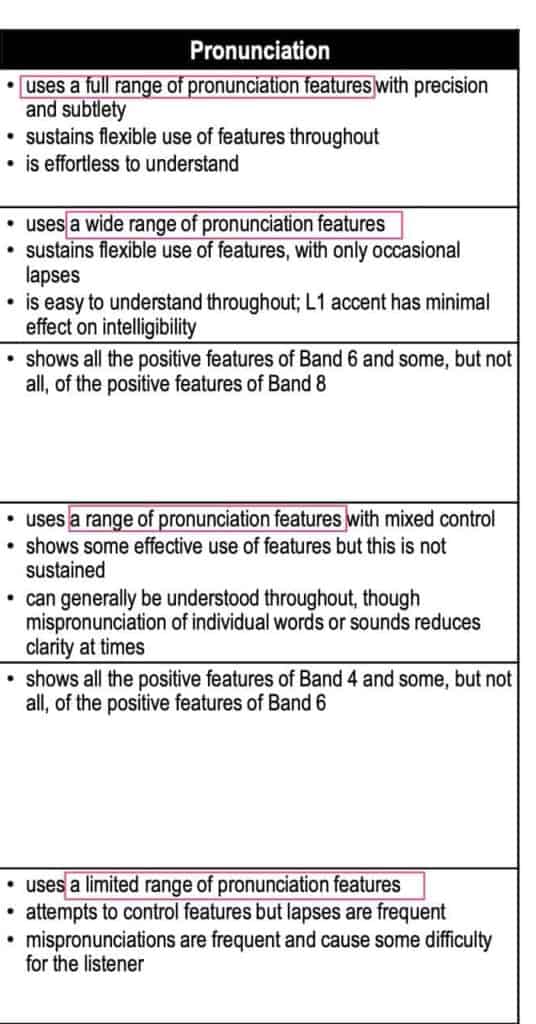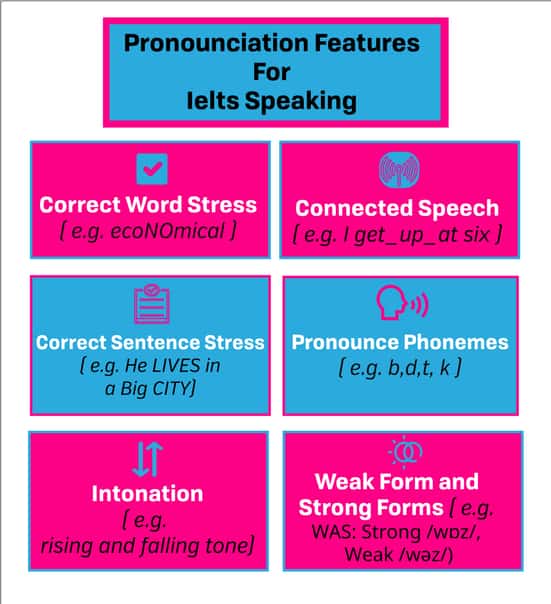IELTS pronunciation is often overlooked by many students and teachers, but clear pronunciation is really important if you want to get a high score in IELTS Speaking.
Pronunciation counts for 25% of your total IELTS Speaking score, so you need to work at it.
Many students ignore it because it takes a lot of hard work to improve and they lack a good guide or coach to help them change the way they speak.
This IELTS Pronunciation Guide will tell you clearly what the main pronunciation features are that you need to work on and how to start improving your English pronunciation.
Table of Contents
How IELTS Pronunciation is Evaluated
Look at how is IELTS Speaking is evaluated:
- Fluency 25%
- Vocabulary 25%
- Grammar 25%
- Pronunciation 25%
Pronunciation in IELTS Speaking counts for 25%
Great, but what is ‘good pronunciation’? What is the examiner looking for?
Well, if you look at the IELTS Speaking Band Descriptors, you will see they talk about ‘pronunciation features‘.

But what are these ‘pronunciation features‘?
Well simply put, the main pronunciation features you need to control and use well are:
- Phonemes (vowels and consonants)
- Word Stress
- Sentence Stress
- Weak and Strong forms
- Connected Speech
- Intonation
Let’s have a look at each one of these in turn.

IELTS Pronunciation: Phonemes
Phonemes include all vowel sounds and consonant sounds.
There are 44 sounds in English that you need to know, including 20 vowel sounds and 24 consonant sounds. Some might be similar in your language, but some will different.
Vowels are ‘open’ sounds where the sound coming from your mouth is not blocked in anyway.
For example,
/æ/ as in hat, cat, man (this is a short vowel)
/i:/ as in see, we, tea (this is a long vowel)
Below we have more vowels and these are diphthongs (meaning you slide from one vowel to another)
- /aɪ/ in ‘I am happy’
- /eɪ/ as in day, say, may
Consonants are sounds where there is some kind of block from either your
- lips
- tongue
- teeth
- palate
For example, the following which are all unvoiced
- p, (pet)
- f, (for)
- θ, (thin)
- t, (tea)
- s, (see)
- ʃ, (sheep)
- ʧ, (chip)
- k, (kite)
And the following which are all voiced
- b, (ball)
- v, (van)
- ð, (that)
- d, (dog)
- z, (zoo)
- ʒ, (vision)
- ʤ, (joke)
- g (get)
These are all voiced consonants
Download the ‘Sounds Right” app here to see the Phonemic Chart with all 44 sounds, and practice them directly on your phone.
American English uses has sone small differences in pronunciation and uses some different symbols for their phonemes.
You can compare the British and American sounds and symbols in this link below:
https://www.adrianunderhill.com/the-pronunciation-charts/
Watch and practice all 44 sounds of English
IELTS Pronunciation: Word Stress
In addition to mastering sounds, a crucial part of successful pronunciation when speaking is knowing how sounds work when we put them together in words.
In words, sounds combine to make syllables.
A syllable is a unit pronunciation made up of a vowel sound and possibly a consonant sound before or/and after the vowel.
For example,
- Two (= 1 syllable)
- Twen – ty (=2 syllables)
- To – mor – row (=3 syllables)
In English, for words with more than one syllable, we stress or emphasise just one of those syllables.
This is called word stress, that is knowing which syllable to stress.
For example, you can see which syllables are stressed in the words below.
- Po – ta – to = / pə – teɪ – təʊ /
- For – get = / fə – get /
- Sa – tur – day = / sæ – tə – deɪ /
When we stress on syllable, we use ‘unstress’ the others. We usually do this by using a Schwa /ə/ sound. You can see this in the examples above.
You can found out which syllable you need to stress from a good dictionary like
https://www.macmillandictionary.com/
https://dictionary.cambridge.org/
Usually they show the phonetic script and will put an apostrophe before the stressed syllable.
IELTS Pronunciation: Sentence Stress
Sentence stress is where we decide which word to stress in a sentence to show meaning or emphasis.
When we stress different words, then the meaning will be different.
Look at how we can stress different words in the same sentence below.
- I lost all my money at the casino.
- I lost all my money at the casino
- I lost all my money at the casino
- I lost all my money at the casino
When see how each one could be the answer to a different question, you will see how the meaning of each one is slightly different.
How much did you lose?
I lost all my money at the casino
Whose money did you lose?
I lost all my money at the casino
What did you lose?
I lost all my money at the casino
Where did you lose it?
I lost all my money at the casino

Weak and Strong forms
Weak and strong forms are the key to successful word and sentence stress.
In spoken English, we normally stress the most important words in a sentence, such as verbs, nouns, adjectives and adverbs.
Most other words in a sentence are usually unstressed. These include
- Auxiliary verbs (to be, have, + modals)
- Prepositions (to, at, for, from…)
- Conjunctions (and, but, than…)
- Pronouns (you, your, he, she, her…)
These words have both a strong form and a weak form.
When the word is unstressed (which is most cases) we use the weak form. If it is stressed, for example at the end of a sentence or when emphasised, we use the strong form.
Here are some examples of the strong and weak forms:
STRONG – WEAK
was / wɒz / / wəz /
for / fɔː / / fə /
to / tuː / / tə /
In the following sentence below, the words waiting, bus and come are stressed, but ‘was’, ‘for’ and ‘to’ are unstressed and so we use their weak forms.
I was waiting for the bus to come
As you can see and hear, most times the unstressed syllable is the Schwa /ə/ sound.
Connected Speech
A very common feature of English pronunciation is Connected Speech, sometimes called Linking.
Basically, this is where we link words together, and is common in more rapid speech. As a rule of thumb, if a word ends in a consonant sound and the next begins with a vowel sound, we can link them.
This is challenging for students because you are often taught ‘words‘ rather than ‘sounds‘ so you cannot often hear where one word starts and another finishes.
In connected speech, phonemes may be linked, they may change their sound slightly, new sounds may be added or even some sounds are dropped and disappear. In addition, we also have contractions.
Here are some examples:
Linking phonemes:
- Wake_up
- First_of_all
- All_in_all
Connected speech and Phrasal verbs
- Take_out
- Give_up
- Take_on
- Put_away
Connected speech and disappearing sounds
- I must go = I mus go
- He must pay = he mus pay
- I must listen = I mus listen

Intonation
Intonation is the way the pitch of a voice goes up and down (falling and rising pitch) and is essential in expressing our meaning.
In many languages changing the pitch or tone of a word can change its meaning. In English we also uses different tones, but we generally use them to show a change in the meaning of a phrase, not just a word.
For example, if I say the following with a rising tone on the last word, it probably means ‘this is very good.’
Well that’s great!
However, it I put a falling tone on the last word, it will more likely mean the opposite, ‘that is terrible’.
Intonation is hard to learn because there are no hard and fast rules. It is something we tend to pick up the more we engage with English.
That said, there are some general guidelines and examples that can be helpful.
Questions.
Closed questions (What, When, Why, Who, Which, How…) usually have a falling intonation.
What time are you coming? ➘
Open questions (yes/no questions) usually have a. arising intonation.
Are you coming?➚
With lists, we often use rising intonation on the first items, and then use a falling intonation on the last one. So, in the example, elephant and tiger have a rising tone, but monkeys has a falling one.
I like elephant➚, tigers➚ and monkeys➘
Conditionals commonly have a rising intonation on the first phrase, and falling on the second.
If you win➚, you will get a prize➘
How to Improve your IELTS Pronunciation
The majority of pronunciation is not done in your head, it’s done in your mouth. So, it’s physical not cognitive.
You have been using your mouth muscles in a certain way to speak your mother tongue.
Now you need to retrain your mouth!
Like going to the gym, you need to practice your pronunciation ‘muscles’. These include,
- Lips
- Tongue
- Jaw
- Voice and unvoiced sounds
At first you will feel uncomfortable, because you are not used to using these muscles in this way.
Use a Coach or Teacher
This is the best way. Someone who is qualified and can help you create the new sounds you need to make. They can also give you feedback on your mistakes.
Use a Pronunciation App
This is like having an ‘on-demand’ teacher in your pocket. There are not many pronunciation apps that I like to be honest, as they often lack good voice recognition and don’t have a good teaching method.
However, one I do like is ELSA. It gives you a structured way of improving your pronunciation.
You get a custom-made learning journey.
It can give you feedback on your mistakes with excellent voice recognition. What’s more, it puts language in context, and it is professionally designed.
Watch Videos
If you don’t have a teacher or coach, you can use videos of native English speakers or proficient speakers. These give you an accurate model to listen to, and you can also hear where your pronunciation is wrong and you need to correct it.
Listen to Audio
Audio doesn’t have the advantage that videos have of being able to see the mouth shape and facial expression, but it is still a good way to practice pronunciation. Listen and repeat. Record yourself and try to listen how you are similar or different from the audio recording.
Read aloud
This is not the best way, but it is a place to start if you have no teacher or English environment. It can help you also connect sound to spelling.
If you want a Band 7 in IELTS Speaking, you will probably need to get a Band 7 in Pronunciation.
This is not easy, and will require a lot of fun work.
I suggest you review all the pronunciation features, try to identify your weaknesses and work on those.
If you want to build your pronunciation, especially intonation, try my online course:




